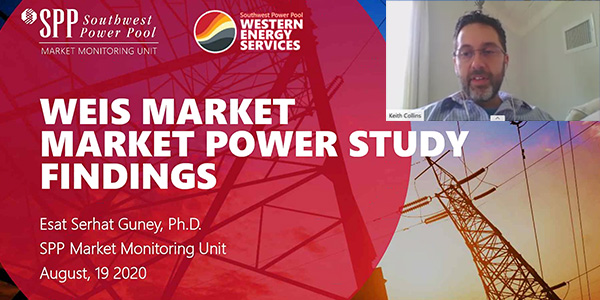SPP staff are working feverishly to address FERC and Market Monitoring Unit concerns that threaten the launch of its Western Energy Imbalance Service (WEIS) market.
FERC last month rejected the RTO’s proposed Tariff for the market, saying it failed to respect nonparticipants’ transmission rights and could improperly burden reliability coordinators. The commission also cited shortcomings on supply adequacy, market power protections and line-loss calculations (ER20-1059, ER20-1060). (See FERC Rejects SPP’s WEIS Tariff.)
On Aug. 3, SPP’s MMU posted a report on a WEIS market study that found “high potential” for structural market power. The Monitor concluded that the WEIS presents “significant structural market power concerns” for energy and imbalance energy that should be addressed before its implementation.
SPP’s regulatory and legal departments are working to revise the Tariff for another filing in early September. Staff have met with the region’s nonparticipants to understand and address their concerns and then fold them into the next filing. They plan to meet with FERC staff in September to lay out a plan for moving forward.

David Kelley, SPP | © RTO Insider
The WEIS working group and executive committee last week passed four revision requests (WRRs) responding to the FERC and MMU issues. Those groups have scheduled two joint meetings this week to hammer out additional WRRs needed to finalize the filing.
Market Design Manager Gary Cate said he is still confident SPP can meet a Feb. 1 deadline for launching the market.
“I think we’ve put together a really good package and minimized changes to everyone’s system involved, and I think we’ve hit directly at what the FERC’s recommendations are. I don’t see why we can’t move forward,” Cate told the Western Markets Executive Committee during its meeting Friday.
David Kelley, SPP’s director of seams and market design, noted that the commission provided specific guidance to help staff respond to the filing’s deficiencies.
“This order was really a good order for us,” he said. “When you read through it, it was very complimentary of our efforts and recognized the benefits of markets being developed in the West. I got the sense the commission was encouraging us to continue developing the WEIS market and address the issues they noted in the order.
“We will know where we stand after meeting with FERC in September,” Kelley said.
The WMEC and Western Market Working Group’s approved revision requests last week included WRR5, a response to FERC’s assertion that there was a lack of justification for automatic increases to market mitigation thresholds and the MMU’s concerns over market power.
SPP based its proposal on its Integrated Marketplace market power mitigation provisions, where it automatically applies mitigation measures to resource offers if the offer exceeds applicable thresholds and fails the market impact test.
The change expands the local market power test to include an assessment of structural market power at the system level. It also “appropriately” mitigates the energy offers when a resource has system-level structural market power and an energy offer curve that exceeds the conduct test threshold, when an impact test has failed for that market interval.
MMU Executive Director Keith Collins said the Monitor “fully supports” WRR5, which borrows from a similar ISO-NE mechanism.

MMU Director Keith Collins shares his thoughts on the WEIS market power study. | SPP
“We think it’s a good alternative,” he said.
The Western markets governance groups also approved three other WRRs:
- WRR2: updates the WEIS protocols to be consistent with SPP’s system change process and modifies the emergency change language to clarify that the RTO will notify stakeholders of the change as soon as practicable.
- WRR3: aligns the WEIS protocols to the Tariff, and documents the changes for the WRR process.
- WRR4: corrects a calculation of the lower operating tolerance for underground residential distribution (URD) and clarifies language expanding URD tolerance during contingency reserve events.
The WEIS currently includes eight members and covers the Western Area Power Administration’s Western Area Colorado Missouri and Western Area Upper Great Plains West balancing authority areas. Several other Western utilities are interested in participating as well, SPP has said.
Market participants are currently undergoing structured testing of SPP’s upstream systems. They are testing data inputs in certain scenarios to ensure they act as expected.




